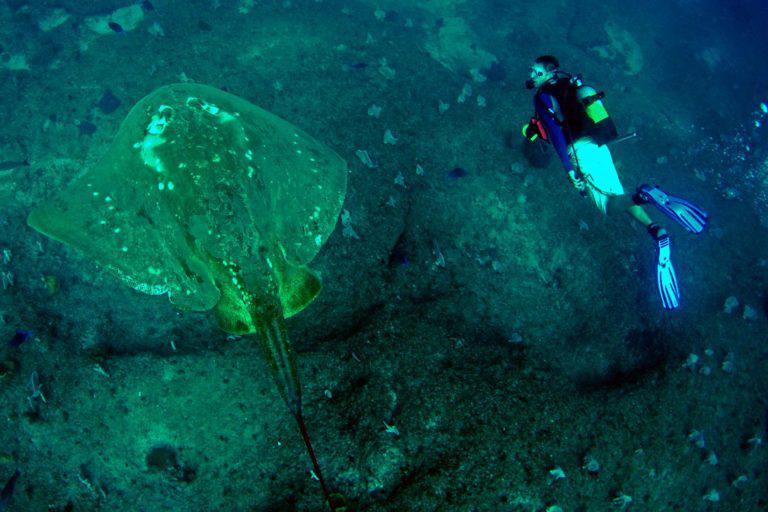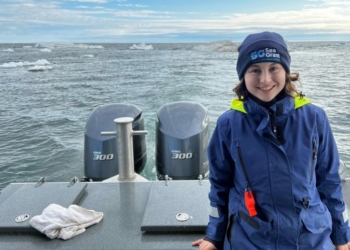In a first for science, the wild smalleye stingray (Megatrygon microps) has been tagged by scientists! Known as the world’s largest and rarest marine stingray, this animal is still globally classified as “Data Deficient” on the IUCN Red List of Threatened Species. Researchers at the Marine Megafauna Foundation (MMF) believe Mozambique’s smalleye stingrays are likely to be subject to artisanal fishing pressures and incidental capture in gill and seine nets. Due to their elusive nature, smalleye stingrays are poorly understood within the scientific and diving communities despite their size. In spite of their distribution throughout the Indo-West Pacific, wild encounters have been rare. In fact, prior to the early 2000s, there were only a few confirmed live sightings of smalleye stingrays!
A scuba diver with a smalleye stingray.
Yet off the eastern coast of Africa seems to be a different story. Southern Mozambique is a global hotspot for sharks and rays, and it seems this also applies to this elusive giant. In Mozambique, about 20 rays are spotted every year at Tofo Beach, making it the best location so far to study them in the wild. But to collect data about these rays takes years, even decades, since there are so few occasions to see them. In 2019, scientists from MMF published Spotting the ‘small eyes’: using photo-ID methodology to study a wild population of smalleye stingrays (Megatrygon microps) in southern Mozambique, the first study of its kind. According to the research, smalleye stingrays have unique and stable patterns on their bodies that can be used to identify them through photography. Through this methodology, 70 rays were identified along southern Mozambican coastlines, using multiple habitats and showing migratory behaviours between them. In contrast to most other stingrays, smalleye stingrays seem to live a very different lifestyle than most other stingrays, which are often sedentary. Smalleye stingrays behave more like the manta rays in the area due to their lifestyle, using the same cleaning stations and being highly mobile.
“In our study, 15 of the 70 identified smalleye stingrays were re-sighted at least once. The longest period between two photographs taken of the same ray was six years, and the spot patterns remained unchanged,” lead author Atlantine Boggio-Pasqua told Oceanographic Magazine. “Further investigation is still required to validate the use of photo-ID on a longer-term basis, but these results are very promising for future studies on smalleye stingrays.”
A diver with a pregnant smalleye stingray in Mozambique.
So how does one thoroughly study an animal? By attaching a tag. Easier said than done when it comes to these giants. Not only are they massive (easily measuring 10 feet/3 meters long and 7 ft/2.1 m across), but the spine lodged at the base of their tail is about as big as an average person’s forearm. Yikes! Imagine getting that lodged into you. Thankfully, they aren’t known for their aggressive towards humans, though incidents have happened with other ray species. Chances are this stinger is reserved for animals brave enough to try to get a chomp out of it, like sharks.
National Geographic explorer and ray expert Andrea Marshall is not a shark.
So she took her chances the animal would not swipe at her dove into the turquoise waters with a six-foot-long pole to obtain a small skin sample from a smalleye stingray’s massive underside… without incident. The fish remained calm, and following this success Marshall and her team formulated a plan to attach tags to these rays, something that has never been done before. Overall, they managed to attach tags – mostly acoustic, some also got satellite – to 11 individuals despite there being some close calls. As Marshall told National Geographic, she “discovered the enormous ray can raise its stinger over its back and swing it around, like a scorpion.”
Diver and smalleye stingray.
Data so far indicate that this animal is very impressive, able to dive over 650 feet deep and swim hundreds of miles per day. According to the study, one of the individuals spent two thirds of his or her time below a hundred feet. Since vision isn’t as crucial in the dark depths, it may explain their “ridiculously small eyes” and poor eyesight. This data also helps bolster personal observations made by divers and even Marshall herself, such as one ray burying itself in the sand after being tagged. “We’re racing against the clock,” she says, “to learn more and get more attention for this incredible species that most people aren’t even aware of.”
We are now on the verge of unraveling a lot of mysteries around these animals. The questions these tags will answer are yet to be determined… but it sure is fun to wait until then.













